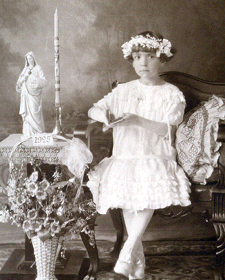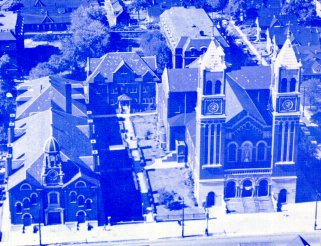
1925 --Sophie Gawel's Communion Day St. Hedwig's Church Matuszewicz Studio 5611 Michigan Avenue
Photo Courtesy of Bob Postula
By 1878, with the growth of industry gradually expanding
to the westside of Detroit, another Polish settlement was organized.
It extended from Twentieth to Twenty-third Streets. In 1882, this
colony built a church on Twenty third and Myrtle Streets, by the name of
St. Casimir's (an earlier attempt to establish a church on the westside in
the 12th Ward, in 1876, was unsuccessful.. By 1890, the parish had
grown so much in numbers that a new church was built, modeled after St.
Peter's basilica in Rome. This imposing edifice, long a
Detroit westside landmark, was torn down in the early
1960's. By 1914, the Polish settlement covered a considerable
portion of the west side, from Maybury Grand to Springwells and from the
Michigan Central Railroad to Warren and McGraw.
The rapid growth of the Polish settlement accounted for the rise of
several schools in the west side Polish settlement: St. Casimir's in
1883, St. Francis d'Assisi in 1892, St.
Hedwig's in 1903 and Assumption of the Blessed Virgin Mary in 1913.
In 1890, the St. Francis
d'Assisi Church and School Building was erected on Campbell and
Buchanon. The present beautiful edifice was dedicated in 1905.
Between 1900 and 1914, the steadily increasing Polish immigration led
to the formation of St. John Cantius in 1902, St. Hedwig in 1903
(the present church was designed by Architect Harry Rill in 1915), and the
Assumption of the Blessed Virgin Mary Church in 1912.

Saint Hedwig's Church 1956 ~~Photo Courtesy of Adam R. Lis

St. Casimir, Corner 23rd and Myrtle Streets
Michigan Catholic, December 1891
The westside Polonians have contributed much to the making of
Detroit, including having one of their own, the late John Kronk, for years
a member of the Detroit City Council.
WEBMASTER'S NOTE: Many of the old residents of this neighborhood worked at the Ford Motor Company plant on Michigan Avenue. These men would take the Michigan Avenue Streetcar to work each day.
Adrian Daily Telegram
Thursday January 2, 1919
Ford Employees To Get Six Dollars Per Day
Detroit, Mich. Jan 2, Henry Ford is going to devote the major portion of
his time during the new year to his new weekly newspaper, the Dearborn
Independent, and to his tractor plant in Dearborn, having formally
resigned
as president of the Ford Motor Company at the annual meeting of the
directors. His son, Edsel B Ford
succeeds him, and B. J. Craig, formerly assistant treasurer, will be the
new secretary: Mr. Craig is a native of Detroit and has been connected
with the Ford concern for 32 (22 hard to read) years.
Coincident with the resignation of Henry Ford, the board of directors
decided to raise the minimum wage of Ford employees, not only in the
Highland Park plant, but all over the country, from $5 to $6 a day, the
same scale to be put in force also at the Fordson Tractor plant. The
increase in wages will affect 28,000 of the 51,000 employees in the Ford
organization.